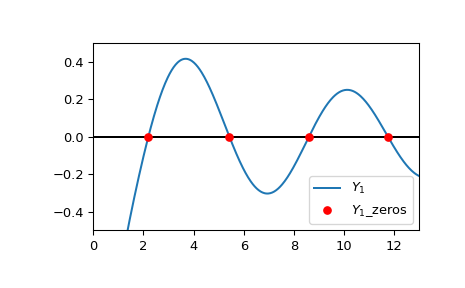scipy.special.
y1_zeros#
- scipy.special.y1_zeros(nt, complex=False)[源代码][源代码]#
计算贝塞尔函数 Y1(z) 的 nt 个零点,并在每个零点处计算其导数。
导数由 Y1’(z1) = Y0(z1) 在每个零点 z1 处给出。
- 参数:
- nt整数
返回的零的数量
- 复杂bool, 默认 False
设置为 False 以仅返回实数零点;设置为 True 以仅返回具有负实部和正虚部的复数零点。请注意,后者的复共轭也是函数的零点,但不会被此例程返回。
- 返回:
- z1nndarray
Y1(z) 的第 n 个零点的位置
- y1pz1nndarray
第 n 个零点的导数 Y1’(z1) 的值
参考文献
[1]张善杰和金建铭。《特殊函数的计算》,John Wiley and Sons, 1996年,第5章。https://people.sc.fsu.edu/~jburkardt/f77_src/special_functions/special_functions.html
示例
计算 \(Y_1\) 的前4个实根及其在根处的导数:
>>> import numpy as np >>> from scipy.special import y1_zeros >>> zeros, grads = y1_zeros(4) >>> with np.printoptions(precision=5): ... print(f"Roots: {zeros}") ... print(f"Gradients: {grads}") Roots: [ 2.19714+0.j 5.42968+0.j 8.59601+0.j 11.74915+0.j] Gradients: [ 0.52079+0.j -0.34032+0.j 0.27146+0.j -0.23246+0.j]
提取实部:
>>> realzeros = zeros.real >>> realzeros array([ 2.19714133, 5.42968104, 8.59600587, 11.74915483])
绘制 \(Y_1\) 和前四个计算出的根。
>>> import matplotlib.pyplot as plt >>> from scipy.special import y1 >>> xmin = 0 >>> xmax = 13 >>> x = np.linspace(xmin, xmax, 500) >>> zeros, grads = y1_zeros(4) >>> fig, ax = plt.subplots() >>> ax.hlines(0, xmin, xmax, color='k') >>> ax.plot(x, y1(x), label=r'$Y_1$') >>> ax.scatter(zeros.real, np.zeros((4, )), s=30, c='r', ... label=r'$Y_1$_zeros', zorder=5) >>> ax.set_ylim(-0.5, 0.5) >>> ax.set_xlim(xmin, xmax) >>> plt.legend() >>> plt.show()

计算 \(Y_1\) 的前4个复数根及其在根处的导数,通过设置
complex=True:>>> y1_zeros(4, True) (array([ -0.50274327+0.78624371j, -3.83353519+0.56235654j, -7.01590368+0.55339305j, -10.17357383+0.55127339j]), array([-0.45952768+1.31710194j, 0.04830191-0.69251288j, -0.02012695+0.51864253j, 0.011614 -0.43203296j]))